《计算机辅助几何造型技术》3_815705192(1)
- 格式:pdf
- 大小:770.23 KB
- 文档页数:56

计算机辅助几何设计含参数保形有理样条插值计算机辅助几何设计(Computer-Aided Geometric Design,简称 CAGD)是计算机科学、数学和工程的交叉学科,它的发展历程可以追溯到20世纪70年代。
CAGD主要是利用计算机帮助人们完成各种几何设计任务,如曲线拟合、曲面建模、数据可视化等等。
其中,参数保形有理样条插值是CAGD中的一种基本技术之一,下面我们将对其进行详细介绍。
一、CAGD简介计算机辅助几何设计是一种利用计算机技术进行几何建模、分析、验证和制造的方法。
CAGD的应用范围非常广泛,涵盖了工业设计、航空航天、汽车制造、医学医疗、艺术设计等领域。
通过CAGD的技术手段,可以在计算机上创建数学模型,并对其进行几何变换、仿真分析、优化求解等操作,从而提高设计效率和质量。
CAGD的发展历程可以追溯到20世纪70年代,当时计算机的性能和软件工具都比较有限,所以主要应用于科学计算和工程仿真领域。
随着计算机技术的飞速发展,CAGD的应用范围也越来越广泛,涌现出了许多优秀的方法和算法,如Bezier曲线、B样条曲线、NURBS曲面、三角网格模型等等。
二、参数保形有理样条插值有理样条曲线是一种常用的数学曲线,它可以用来表示各种形状的曲线和曲面。
和其他曲线表示方法相比,有理样条曲线具有重要的优点,如良好的几何性质、局部控制性能、优秀的逼近性能等等。
参数保形有理样条插值是有理样条曲线中的一种插值方法,它可以通过已知的插值点来构造一条参数保形的有理样条曲线。
插值问题是求解函数$f(x)$在一些已知点$x_i$处的函数值$f(x_i)$的问题。
对于一些简单的函数,这个问题可以直接求解。
但是对于复杂的函数,如曲线和曲面,这个问题并不容易解决。
在实际应用中,经常需要求解一条曲线通过已知点,并且曲线在每个插值点处具有特定的曲率、斜率等属性。
这个问题就可以通过参数保形有理样条插值方法来解决。
参数保形有理样条插值是一种基于控制点的插值方法。
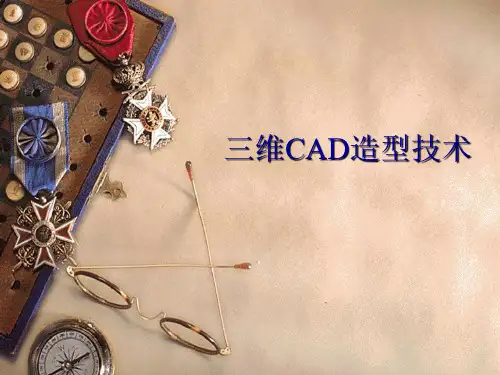
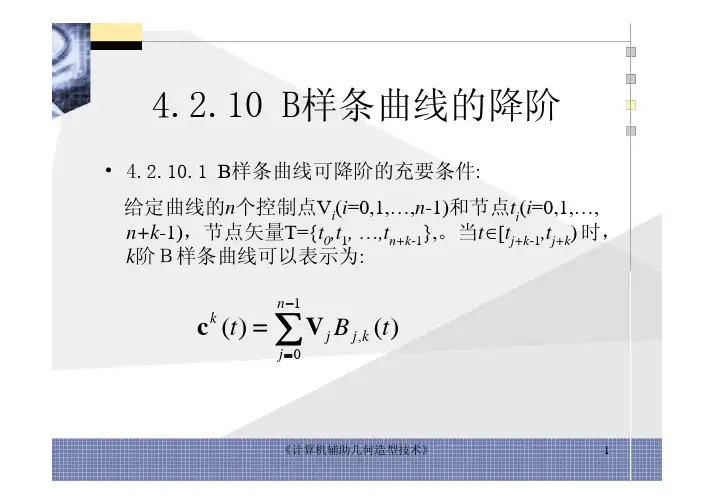

计算机辅助几何造型技术主讲教师:秦开怀教授、博导qkh-dcs@所在单位:清华大学计算机科学与技术系 时间:2007年9月~2008年1月Textbooks/ReferencesJ. Hoschek& D. Lasser, Fundamentals of Computer Aided Geometric Design A K Peters Computer Aided Geometric Design, A K Peters, Ltd, Massachusetts, 1993.David F Rogers Introduction to NURBS Morgan David F Rogers,Introduction to NURBS, Morgan Kaufmann,2001.L Piegl&W Tiller The NURBS Book(2L. Piegl & W. Tiller, The NURBS Book (2nd Edition), Springer-Verlag Berlin Heidelberg, NewYork, 1997.York1997Carl deBoor, A Practical Guide to Splines, New York, Springer Verlag, 1978.York Springer-Verlag1978(Continued)M. E. Mortenson, Geometric Modeling , J h W l &S I 1985John Waley & Sons, Inc., 1985. G. Farin, Curves and Surfaces for ,Computer Aided Geometric Design (5th Edition), Elsevier Inc., 2002.(李双喜译,),,(CAGD 曲线曲面,科学出版社,2006)E J Stollnitz T DeRose &D H Salesin E. J. Stollnitz, T. DeRose & D. H. Salesin, Wavelets for Computer Graphics, Theory & Morgan Kaufmann PublishersApplications , Morgan Kaufmann Publishers, Inc., San Francisco, 1996.(Continued)Denis Zorin & Peter Schroder, Subdivision for M d li d A i ti SIGGRAPH 2000Modeling and Animation , SIGGRAPH 2000 Course Notes #23, 2000. R. Barzel, Physically-Based Modeling for Computer Graphics, A Structured Approach,Academic Press, Inc., San Diego, 1992.D. N. Metaxas, Physic-Based Deformable ,yModels, Applications to Computer Vision, Graphics & Medical Imaging , Kluwer Academicp g g ,Publishers, Massachusetts, 1997.(Continued)Donald Hearn & M.Pauline Baker, C t G hi ith O GL (Thi d Computer Graphics with OpenGL (Third Edition), Pearson Education, 2004 (中译本赫恩等著本:赫恩等著, 蔡士杰等译,《计算机图形学(第三版)》, 电子工业出版社, 200506)2005-06.) J. D. Foley, et al, Computer Graphics: y,,p pPrinciples & Practice (2nd Edition in C),Addison-Wesley, Reading, MA, 1996.y,g,,G di P li Grading PolicyThree assignments 30%Discussions/learning in classroom 5% One project substituting for the final p j g examination 65%R kRemarksThe three assignment is to be completed individually on yourself, but discussions among fellow students areyourself but discussions among fellow students areallowed.The project substitutes for the final examination Two The project substitutes for the final examination. Twostudents can work together as a group.Absolutely no sharing or copying of any code for both Absolutely no sharing or copying of any code for boththe assignments and the project! Offenders will be givena failure grade and the case will be reported to theg pdepartment.You are welcome to turn off your mobile phone before You are welcome to turn off your mobile phone beforeattending lectures.This course concentrates on seven main issues:i iNURBS curves and surfaces (including Bezier, B-spline curves and surfaces)gTriangular surfacesGordon-Coons surfacesSubdivision surfaces of arbitrary topologySubdivision surfaces of arbitrary topologyThe 2nd generation wavelets for multi-resolution modelingmodelingSolid modelingNew technology for geometric modelingContents of This Course1.Introduction2.∆Mathematic BasicsAffine mapsAffine mapsDivided differenceFunction spaceGeometric basics from curves and surfaces 3.∆Interpolatory Polynomial SplinesHermite interpolationHermite interpolationContents of This Course Contents of This Course (Continued)Quadric polynomial spline curvesCubic polynomial spline curvesSolving a linear system of equations with a g y q tridiagonal coefficient matrix Cubic parametric spline curves Cubic parametric spline curves4.*Bezier Curves and Surfaces Bezier curves defined by edge vectorsBernstein-Bezier curvesProperties of Bernstein-Bezier curves(Continued)De Casteljau algorithmDi t ti f B iDiscrete generation of Bezier curvesDegree elevation of Bezier curvesD d i f B iDegree reduction of Bezier curvesBezier spline curvesBezier interpolation curvesMatrix formula of Bezier curvesRational Bezier curvesProduct & inner product of Bezier curves Bezier surfaces(Continued)5.*B-spline Curves and SurfacesB-spline basis functions and their p ppropertiesB-spline curvesOpen curves and knot vectorsOpen curves and knot vectorsUniform B-spline curvesEndpoint interpolating B spline curves Endpoint interpolating B-spline curvesClosed B-spline curves(Continued)Chaikin algorithmDe Boor algorithmInserting knots in B-spline curves Inserting knots in B spline curvesBoehm algorithmOlso algorithmGeneral knot insertion for B-spline curvesDegree elevation of B-spline curves Degree elevation of B-spline curvesMarsden identity and recursive degree elevationPrautzsch algorithm(Continued)Arbitrarily high degree elevation for B-spline curvesDegree reduction of B-spline curvesB-spline surfacesInterpolating B-spline curves and p g p surfaces Matrix formulas of B-spline curves and Matrix formulas of B spline curves and surfaces(Continued)Matrix formula of uniform B_spline curvesMatrix formula of non-uniform B_splines Inner product of B-spline curvesGeneralized Marsden identityB-spline curve productInner product of B-spline basis functionsInner product of B-spline curves6.*NURBS Curves and SurfacesNURBS curvesNURBS curvesRepresenting conics using NURBS(Continued)Parameterization of curvesfNURBS surfacesRepresenting quadrics using NURBS surfacesfInterpolating NURBS curves and surfaces 7.Blossoming PrincipleLooking at de Casteljau algorithm from a Looking at de Casteljau algorithm from a blossoming point of viewKnot insertion from a blossoming point of Knot insertion from a blossoming point of view(Continued)Generating de Boor points based on the blossoming principleblossoming principleDegree raising of B-spline curves by blossoming8.* Triangular SurfacesBarycentric coordinatesgTriangular Bezier surfacesContinuity conditions for triangular Bezier ppatchesRational Triangular surfaces(Continued)9.*Gordon-Coons SurfacesCoons surfacesGordon-Coons surfaces on rectanglesGordon-Coons surfaces on triangles0Subd s o Su a s o b a y 10.*Subdivision Surfaces of ArbitraryTopologyCatmull-Clark surfacesCatmull-Clark surfacesDoo-Sabin surfacesContinuity of uniform subdivision surfaces Continuity of uniform subdivision surfacesNon-uniform subdivision surfaces(Continued)Convergence and continuity of non-uniform subdivision surfaces11.*The 2nd Generation Wavelets forMulti-resolution modelingMulti-resolution modelingB-spline wavelets for Multi-resolution modeling Endpoint interpolating B-spline wavelets Endpoint interpolating B-spline waveletsArbitrary Non-uniform B-spline waveletsB-spline wavelets with constraintsB spline wavelets with constraintsSubdivision-based Surface waveletsLoop Subdivision WaveletsCatmull-Clark Subdivision Wavelets√3-subdivision-based Bi-orthogonal Wavelets(Continued)12.∆Scattered Data Interpolation13.*Intersections of Curves and Surfaces14.Solid Modeling14*Solid Modeling15.Parameterization Modeling for ShapeDesign and Feature-based Modeling 16.New Technology for Geometric 16.*New Technology for GeometricModelingHierarchical B splinesHierarchical B-splinesPhysics-based modelingContents of This Course Contents of This Course (Continued)Modeling fractalized scenes (mountains,f lowers etc.)Particle system for modeling fires, clouds, water, forests etc.1.Introduction1. IntroductionSome Applications of CAGDRepresentation of large data setsVisualizing productsAutomatically producing sectionalAutomatically producing sectional drawingsModeling surfaces arising inModeling surfaces arising in construction of cars, ships & airplanesDesigning pipe systems, e.g. in chemical plants(continued)Drawing marine charts and city and relief i h maps in cartographyProduction and quality control, e.g. in q y ,g the sewing machine, textile and shoe industriesPlanning and controlling surgery Creating images in advertising television Creating images in advertising, television and film industries(continued)Constructing virtual environmentsDescribing robot paths and controlling their movementstheir movementsControlling milling machines used in manufacturingCurve modeling with constrained B-spline wavelets 保特征点的多分辨率曲线造型29曲线的多分辨率分段无缝表示30细分曲面带约束的样条曲面小波左图是采用经典B 样条曲面小波分片多分辨率表示的结果,右图是采用带约束B 的样条曲面小波分片多分辨率表示的结果,其中约束施加在接合线处。
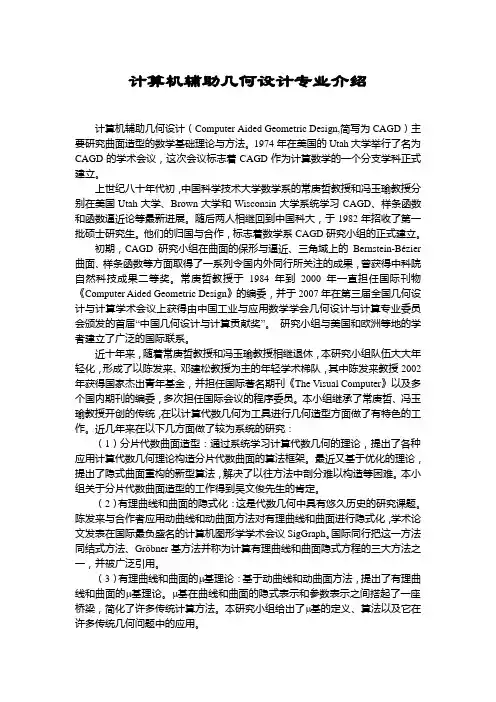
计算机辅助几何设计专业介绍计算机辅助几何设计(Computer Aided Geometric Design,简写为CAGD)主要研究曲面造型的数学基础理论与方法。
1974年在美国的Utah大学举行了名为CAGD的学术会议,这次会议标志着CAGD作为计算数学的一个分支学科正式建立。
上世纪八十年代初,中国科学技术大学数学系的常庚哲教授和冯玉瑜教授分别在美国Utah大学、Brown大学和Wisconsin大学系统学习CAGD、样条函数和函数逼近论等最新进展。
随后两人相继回到中国科大,于1982年招收了第一批硕士研究生。
他们的归国与合作,标志着数学系CAGD研究小组的正式建立。
初期,CAGD研究小组在曲面的保形与逼近、三角域上的Bernstein-Bézier 曲面、样条函数等方面取得了一系列令国内外同行所关注的成果,曾获得中科院自然科技成果二等奖。
常庚哲教授于1984年到2000年一直担任国际刊物《Computer Aided Geometric Design》的编委,并于2007年在第三届全国几何设计与计算学术会议上获得由中国工业与应用数学学会几何设计与计算专业委员会颁发的首届“中国几何设计与计算贡献奖”。
研究小组与美国和欧洲等地的学者建立了广泛的国际联系。
近十年来,随着常庚哲教授和冯玉瑜教授相继退休,本研究小组队伍大大年轻化,形成了以陈发来、邓建松教授为主的年轻学术梯队,其中陈发来教授2002年获得国家杰出青年基金,并担任国际著名期刊《The Visual Computer》以及多个国内期刊的编委,多次担任国际会议的程序委员。
本小组继承了常庚哲、冯玉瑜教授开创的传统,在以计算代数几何为工具进行几何造型方面做了有特色的工作。
近几年来在以下几方面做了较为系统的研究:(1)分片代数曲面造型:通过系统学习计算代数几何的理论,提出了各种应用计算代数几何理论构造分片代数曲面的算法框架。
最近又基于优化的理论,提出了隐式曲面重构的新型算法,解决了以往方法中剖分难以构造等困难。
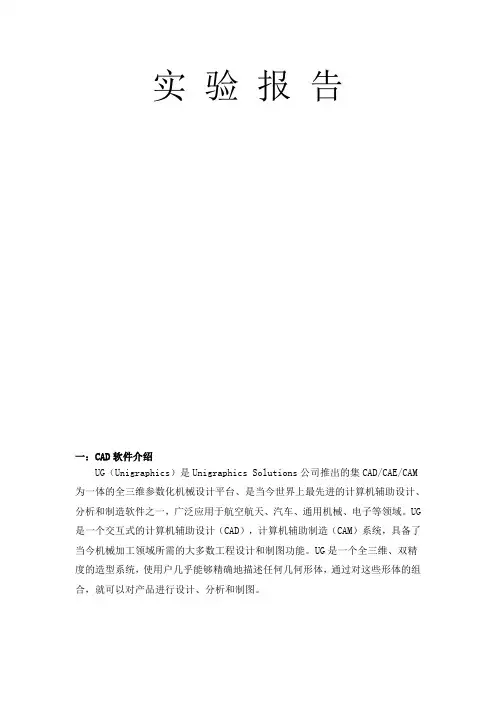
实验报告一:CAD软件介绍UG(Unigraphics)是Unigraphics Solutions公司推出的集CAD/CAE/CAM 为一体的全三维参数化机械设计平台、是当今世界上最先进的计算机辅助设计、分析和制造软件之一,广泛应用于航空航天、汽车、通用机械、电子等领域。
UG 是一个交互式的计算机辅助设计(CAD),计算机辅助制造(CAM)系统,具备了当今机械加工领域所需的大多数工程设计和制图功能。
UG是一个全三维、双精度的造型系统,使用户几乎能够精确地描述任何几何形体,通过对这些形体的组合,就可以对产品进行设计、分析和制图。
UG自从1990年,进入我国以来,以其强大的功能和工程背景,已经在我国的航空、航天、汽车、模具和家电等领域得到广泛的应用。
尤其UG软件PC版本的推出,为UG在我国的普及起到了良好的推动作用。
实验一曲线造型综合性实验实验内容及结果:1.新建文件名(注意不能有中文名或者是中文目录) spline1.part,选择建模模块,构造型值点:插入(S)—〉基准/点—〉点(P),在点构造器中输入型值点的坐标或者直接用鼠标取点在工具栏空白处点右键选取曲线,并在弹出的工具栏中点取工具条右上角小箭头,将样条,艺术样条选上,/(a)通过极点:1.指定曲线阶次,确定进入下一步。
2.弹出点构造器对话框,选取前面构造的型值点,然后点确定进入下一步。
(b) 通过点的方式构造曲线:1.指定曲线阶次,确定进入下一步2.弹出样条对话框,选取“全部成链“进入下一步。
3.在弹出的“指定点”对话框中选取前面构造的型值点起点和终点,确定进入下一步4.在弹出的对话框中,点确定生成曲线。
(c)拟合5.点击“拟合”后,弹出样条对话框,选取“全部成链“进入下一步。
6.在弹出的“指定点”对话框中选取前面构造的型值点起点和终点,确定进入下一步7.在弹出的对话框中选择拟合方法,修改样条拟合条件,点确定生成曲线。
2.在工具条中选取艺术样条曲线的构造方法:由型值点直接生成样条。
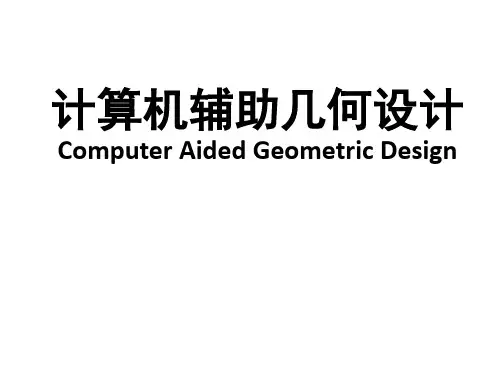
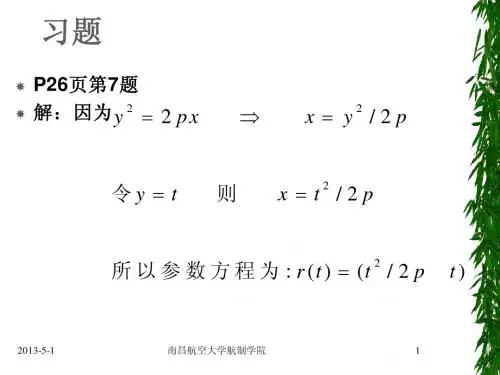

![[高等教育]计算机辅助几何造型技术-第2章](https://uimg.taocdn.com/e55083ddf705cc17552709a6.webp)
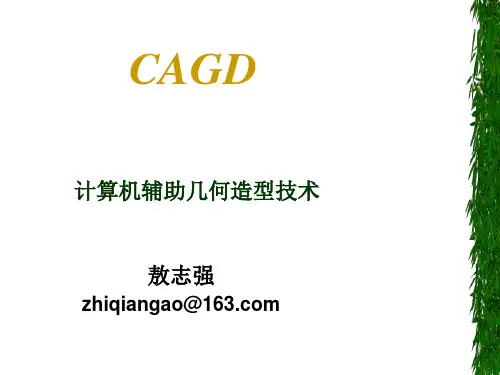
计算机辅助几何造型设计复习题1、几何造型是指能将物体的形状及其属性(颜色、纹理等)存储在计算机内,形成该物体的三维几何模型的技术。
几何造型在图形生成、产品设计、制造及装配中得到广泛的应用。
2、CAD技术起步于50年代后期。
进入60年代,随着在计算机屏幕上绘图变为可行而开始迅速发展。
在CAD软件发展初期,CAD的含义仅仅是图板的替代品,即:意指Computer Aided Drawing(or Drafting)而非现在我们经常讨论的CAD(Computer Aided Design)所包含的全部内容。
人们希望借助此项技术来摆脱繁琐、费时、绘制精度低的传统手工绘图。
此时,CAD技术的出发点是用传统的三视图方法来表达零件,以图纸为媒介进行技术交流,这就是二维计算机绘图技术。
CAD技术以二维绘图为主要目标的算法一直持续到70年代末期,以后作为CAD技术的一个分支而相对单独、平稳地发展。
进入80年代中期,CAD技术的研究又有了重大进展,提出了一种比无约束自由造型更新颍、更好的算法──参数化实体造型方法。
进入90年代,参数化技术逐渐成熟起来,充分体现出其在许多通用件、零部件设计上存在的简便易行的优势。
早期应用较为广泛的是CADAM软件,近十年来占据绘图市场主导地位的是Autodesk公司的AutoCAD软件。
下面简要介绍CAD技术的四次技术创新。
1)第一次CAD技术革命——曲面造型技术60年代出现的三维CAD系统只是极为简单的线框式系统。
这种初期的线框造型系统只能表达基本的几何信息,不能有效表达几何数据间的拓扑关系。
由于缺乏形体的表面信息,CAM及CAE均无法实现。
进入70年代,飞机和汽车工业蓬勃发展,飞机及汽车制造中遇到了大量的自由曲面问题,当时只能采用多截面视图、特征纬线的方式来近似表达所设计的自由曲面。
由于三视图方法表达的不完整性,经常发生设计完成后,制作出来的样品与设计者所想象的有很大差异甚至完全不同的情况。